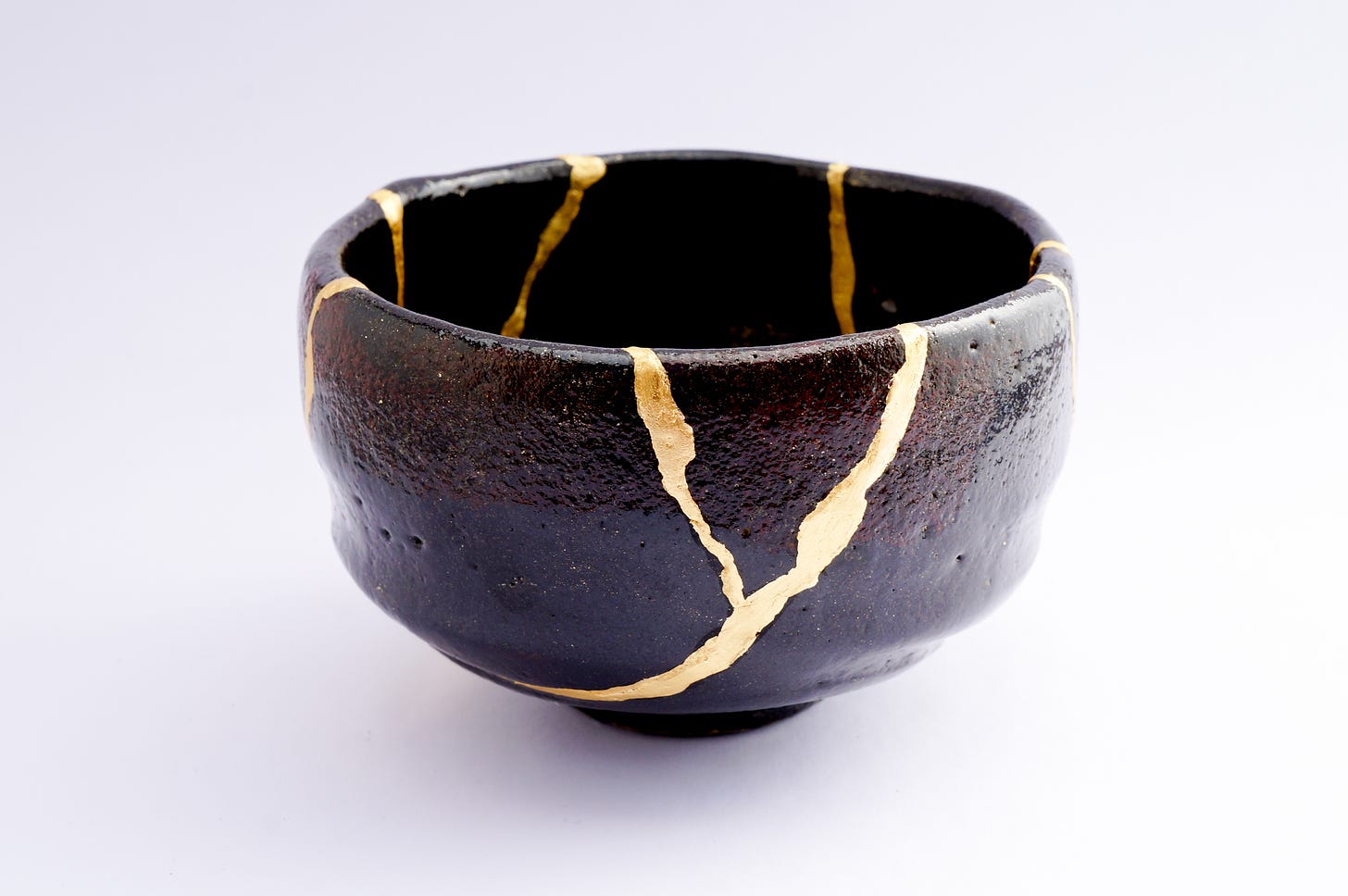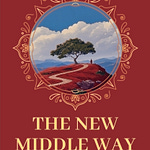Kintsugi is the Japanese art of repairing broken pottery with a lacquer mixed with powdered gold. The image came to me as I considered a brief way to describe tonglen, the Tibetan Buddhist meditation practice of breathing in the suffering of others and breathing out healing. We receive what’s broken and return what’s whole.
The practice of kintsugi, which began in 14th-century Japan, demonstrates how beauty can be found in imperfection. It’s linked to the philosophy of wabi-sabi, acceptance of impermanence and imperfection. It may be that wabi-sabi is related to early Japanese Buddhism and Zen. Here’s a link to an essay that explores the traditions.
That’s a lot to take in, so let’s pause for a brief silent contemplation of suffering and healing…brokenness and wholeness…impermanence and beauty.
The teachings of the revered 8th-century Buddhist philosopher Shantideva are sometimes cited as the basis for tonglen. In what has become a classic Buddhist text, The Way of the Bodhisattva, he wrote:
Do not be downcast, but marshal all your powers; Make an effort; be the master of yourself! Practice the equality of self and other; Practice the exchange of self and other.
Lojong (mind-training) practices expanded on the exchange of self and other. Here’s Verse 7 from Eight Verses of Training the Mind, written in the 11th or 12th century:
In brief, directly or indirectly, I will offer help and happiness to all my mothers, And secretly take upon myself All their hurt and suffering.
“Mothers” here means all beings, based on the Tibetan belief that every being has been the mother of every other being over the eons.
Before practicing tonglen, one should feel grounded. I’d suggest avoiding it unless you feel whole. On the other hand, if you’re comfortable with your spiritual path and meditation practice, practicing tonglen in a generalized way can help you develop your compassion and loving-kindness.
By that, I mean imagining the peace and well-being within you as a substance with shape and color—then imagining the world’s suffering as another shape outside of you with a different color. You first ground yourself in the embodiment of your well-being and then begin breathing in the external substance and breathing out the internal healthy one.
At later stages, we can get more specific with our tonglen. Here’s where it’s especially wise not to do this unless you feel grounded in equanimity. If you’re an empath—especially vulnerable to absorbing others’ pain—this is not the practice for you. If you are comfortable in equanimity, you can relieve others’ suffering without taking on more pain. Your compassionate and loving equanimity is limitless, even if your empathy is not. That’s worth repeating:
Your compassionate and loving equanimity is limitless, even if your empathy is not.
I began practicing tonglen in a generalized way to enhance my loving-kindness and soon began applying it to individuals. I began with a man who has dementia and wants to live. I breathe in his disease and beathe out my strength. With another man with dementia—this one wanting to die—I breathed in any lingering thoughts that might be holding him back and breathed out my acceptance of death.
When I’m in the physical presence of the other person, I might add some Buddhist chants if they fit within that person’s belief system. Sometimes, I do tonglen for people hundreds or thousands of miles away. I believe strongly that the interconnected web is much more than a metaphor. Our thoughts, our intentions, our prayers, and our actions all have an impact near and far.
For this reason, tonglen brings healing to others as it reinforces one’s own loving-kindness. If you’d like to try it, I won’t take you further than you want. I’ll give you a few moments to find a comfortable and private place to meditate.
[Ring bell 3 times]
You’re relaxed with your back reasonably straight, so air can flow in and out smoothly. Your eyes can be open or closed. You scan your body to relax any knots of tension.
Focus your awareness on whatever part of your body is in contact with the ground or something else. What does that feel like? Does it have a temperature? Is there a vibration there?
Now, focus your attention on your breath. How does the air feel as it approaches and enters your nostrils? Follow it down into your lungs and then out again. You might try exhaling through your mouth. Inhale through your nose, exhale through your mouth.
Now, see if you can find an area of compassion, clarity, and wisdom within yourself. It’s not really in any one place. It’s limitless, but it may feel centered in your heart. Rest your awareness there.
Imagine before you a symbol of love, calm, and strength. The image could be in a human or other form. It’s whatever or whoever represents love, calm, and strength for you. It’s glowing with light like the sun’s as it dissolves into you.
As you breathe in, you feel its warmth. Now, you imagine before you a mass of suffering in a dark color—maybe gray. You feel as though the yellow glow within you is limitless so you exhale its warmth and light into the dark cloud and inhale the dark suffering, which becomes absorbed in the yellow within.
You continue like this for a while.
[Pause]
You can continue to inhale the world’s suffering and exhale a healing light, or if you are feeling stable and whole, you might imagine a loved one or perhaps a group that’s suffering. Imagine that person or group in front of you. Inhale the suffering and exhale the healing light.
You’re aware that exchanging your loving equanimity for the suffering of others benefits both the sender and receiver.
You can remain in a tonglen exchange with one or more people or with the world’s general suffering as long as it’s comfortable until you hear the bell ring three times.
[Long pause]
[Ring bell 3 times]
A dedication prayer1 to close:
By the power of this compassionate practice May suffering be transformed into peace. May the hearts of all beings be open And their wisdom radiate from within.
From the Pure Land has subscribers in 28 U.S. States and 12 countries. The podcast has listeners in 25 countries. Consider:
Becoming a subscriber if you are not one already. Free and paid subscribers receive the same content, but subscribing for $5 a month or $50 a year helps support my mission.
Making a one-time gift of any amount.
Sharing this post with a friend.
Listening and subscribing to the From the Pure Land podcasts via your favorite app or by clicking here.
From the Dharmata Fellowship.














Share this post